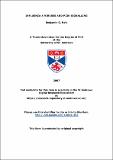Influenza A viruses and PI3K signalling
Abstract
The influenza A virus non-structural (NS1) protein is multifunctional, and during virus-infection NS1 interacts with several factors in order to manipulate host-cell
processes. This study reports that NS1 binds directly to p85β, a regulatory subunit of phosphoinositide 3-kinase (PI3K), but not to the related p85α. Expression of NS1 was sufficient to activate PI3K and cause the phosphorylation of a downstream mediator
of PI3K signalling, Akt. However, in virus-infected MDCK cells, the kinetics of Akt phosphorylation did not correlate with NS1 expression, and suggested that negative regulation of this signalling pathway occurs subsequent to ~8h post-infection.
Mapping studies showed that the NS1:p85β interaction is primarily mediated by the NS1 C-terminal domain and the p85β inter-SH2 (Src homology 2) domain. Additionally, the highly conserved tyrosine at residue 89 (Y89) of NS1 was found to be important for binding and activating PI3K in a phosphorylation-independent manner. The inter-SH2 domain of p85β is a coiled-coil structure that acts as a scaffold for the p110 catalytic subunit of PI3K. As NS1 does not displace p110 from the inter-SH2 domain, a model is proposed whereby NS1 forms an active heterotrimeric complex with PI3K, and disrupts the ability of p85β to control p110 function.
Biological studies revealed that a mutant influenza A virus (Udorn/72) expressing NS1 with phenylalanine substituted for tyrosine-89 (Y89F) exhibited a small-plaque phenotype, and grew more slowly in MDCK cells than wild-type virus. Unexpectedly, another mutant influenza A virus strain (WSN/33) expressing NS1-Y89F was not
attenuated in MDCK cells, yet appeared to be less pathogenic than wild-type in vivo.
Overall, these data indicate a role for NS1-mediated PI3K activation in efficient influenza A virus replication. The potential application of this work to the design of
novel anti-influenza drugs and vaccine production is discussed.
Type
Thesis, PhD Doctor of Philosophy
Collections
Items in the St Andrews Research Repository are protected by copyright, with all rights reserved, unless otherwise indicated.

